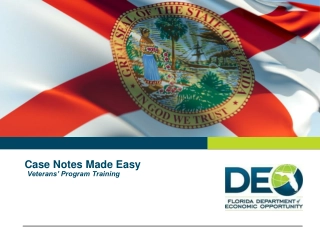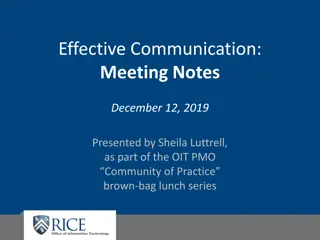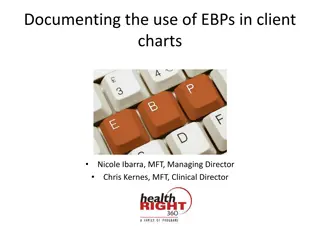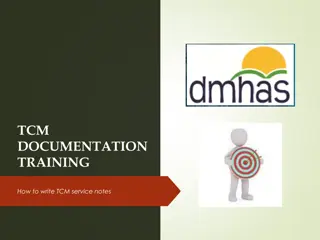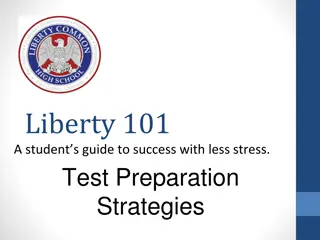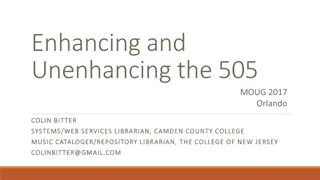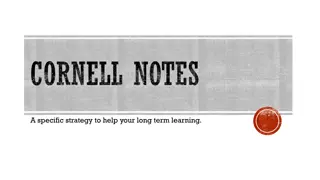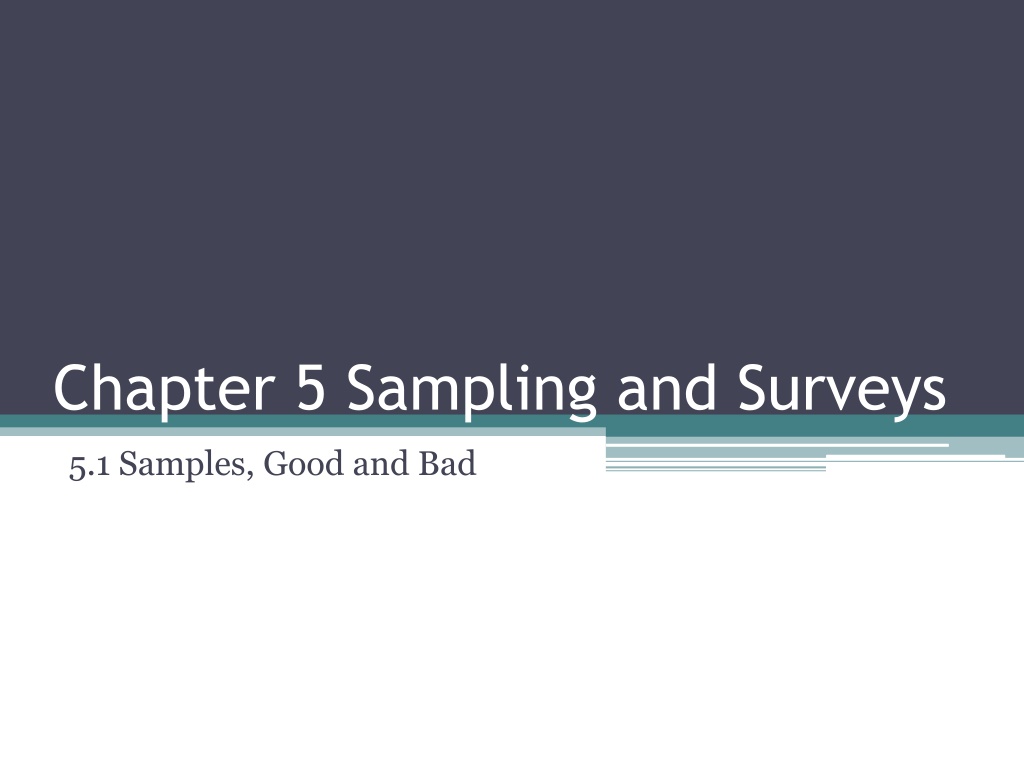
Sampling Techniques in Statistics
Understand the importance of unbiased samples in statistical studies by exploring various sampling techniques such as voluntary response samples, convenience samples, and simple random samples. Learn how biased samples can impact study outcomes and the significance of representative samples. Practice your knowledge with practical examples to enhance your understanding.
Uploaded on | 0 Views
Download Presentation

Please find below an Image/Link to download the presentation.
The content on the website is provided AS IS for your information and personal use only. It may not be sold, licensed, or shared on other websites without obtaining consent from the author. If you encounter any issues during the download, it is possible that the publisher has removed the file from their server.
You are allowed to download the files provided on this website for personal or commercial use, subject to the condition that they are used lawfully. All files are the property of their respective owners.
The content on the website is provided AS IS for your information and personal use only. It may not be sold, licensed, or shared on other websites without obtaining consent from the author.
E N D
Presentation Transcript
Chapter 5 Sampling and Surveys 5.1 Samples, Good and Bad
Bias Design flaw of a statistical study that systematically favors certain outcomes. Systematically favoring one outcome over another Samples Sample is a small group from a larger population. Representative samples have the same characteristics of the larger population
BIASED SAMPLES: Voluntary Response Sample Individuals choose to become part of the sample by responding to a general request. Very biased in that many reply with extreme or strong opinions on the subject matter. Not a representative sample since not all people would choose to respond. EX: Call-in, write-in, asking people at the mall to stop, etc.
Convenience Sample Selection of individuals that are easily obtained. Biased Not a representative sample.
Practice: p. 205 #2-4 5.2 An online poll (a) Voluntary Response Sample (b) The sample is limited to those that read Parade, those that have access to online services, and were willing to go to the website to vote. The 85% is probably higher than the true percent of all adults who believe that cell phone use while driving should be banned. People that are for the ban on cell phones would probably have stronger feelings on the subject and be more likely to go online to complete the survey.
5.3 Sleepless nights (a) Convenience Sample (b) Since the student chose the first 100 to arrive these students had probably had a good night sleep, awoken refreshed, and made it to school early. The average is probably higher than the true average since those that did not sleep well or went to bed late probably hadn t made it to school yet. 5.4 Hand-washing habits (a) When asked the question most people would not admit to not washing their hands. (b) The observers did not want to bias the study by letting the people be aware of being watched. If the people knew they were being studied they might behave in a different manner.
Unbiased Sample Simple Random Sample (SRS) Sample of size n from a population chosen in such a way that: 1. Every individual of the population has the same chance of being selected 2. Every possible sample of size n has the same chance of being selected.
Example: 4 Students need to be selected to represent the class in Statistics Conference in Cancun during Spring Break. 1. Put everyone s name in hat, mix it up, and select 4 names. X 2. Put all the boy s names in one hat and all the girl s names in a second hat. Randomly select 2 boys and 2 girls.
How to take a SRS: Table of Random Digits (table B)- A long string of digits (0-9) with the following properties: Each digit in the table is equally likely to be any of the 10 digits The entries are independent of each other. So knowing one digit doesn t affect what the next one is.
HOW TO USE THE TABLE: 1) LABEL * Label each individual in your population with a # * Each # given must have the same amount of digits 2) TABLE * Go to the table, read across in groups that are the same size as the numbers you assigned
How to write instructions for SRS: Label each _______ with #__ -- __ Use TRD, read across, every ____ digits represent a ______. Ignore # s ________, and repeats The first _____ numbers are our sample
EXAMPLE: Take a sample 5 from the following list. Start at line 131 in the table. Smith Jones Holloway DeNizzo David Adams Schaefer Gray Capito Meyers Gingrich Card Dietrich Moreland Hall Walsh Whitter Jordan
Instructions 1. Assign 01-18 to each of the people 2. Read across the TRD, every 2 digits represents a person 3. Ignore 19-99,00 and repeats 4. The first 5 numbers are our sample
EXAMPLE: Take a sample 5 from the following list. Start at line 131 in the table. 01 Smith 07 Jones 13 Holloway 02 DeNizzo 08 David 14 Adams 03 Schaefer 09 Gray 15 Capito 04 Meyers 10 Gingrich 16 Card 05 Dietrich 11 Moreland 17 Hall 06 Walsh 12 Whitter 18 Jordan
* Read across table every 2 digits and circle numbers between 01 and 18, ignoring repeats, til you find 5 numbers. Line 131: 05|00|7 1|66|32| 81|19|4 1|48|73| 04|19|7 8|55|76| 45|19|5 9|65|65 Line 132: 68|73|2 5|52|59| 84|29|2 0|87|96| 43|16|5 9|37|39 31|68|5 9|71|50 Line 133: 45|74|0 4|18|07| 65|56|1 3|33|02 |07|05|1
EXAMPLE: Take a sample 5 from the following list. Start at line 131 in the table. 01 Smith 07 Jones 13 Holloway 02 DeNizzo 08 David 14 Adams 03 Schaefer 09 Gray 15 Capito 04 Meyers 10 Gingrich 16 Card 05 Dietrich 11 Moreland 17 Hall 06 Walsh 12 Whitter 18 Jordan
Practice - p. 209 #7 9, 12 (7) Apartment Living Instructions: 1. Label each apartment complex with #01-33 2. Read across TRD, every 2 digits is an apartment complex. 3. Ignore 00, 34-99 and repeats 4. First 3 complexes are our sample Line 117: 38|16|7 9|85|32 | 62|18|3 Complexes: Fairington, Waterford Court, Fowler
(8) How do random digits behave? (a) False (b) True (c) False (9) An election day sample (a) Instructions: 1. Label each precinct with #001 440. 2. Read across TRD, every 3 digits = one precinct. 3. Ignore 000, 441-999 and repeats. 4. The first 25 precincts are our sample
82739 57890 20807 47511 81676 55300 94383 14893 60940 72024 17868 24943 61790 90656 87964 18883 36009 19365 15412 39638 85453 46816 83485 41979 Precincts: 395, 020, 118, 167, 300, 360, 241, 065, 188, 365
(12) (a)They would have to wait until the day s production was done, give each phone a number and randomly select. Then it would take 200 minutes (20 phones * 10 min inspection each) to inspect them, which is an extra few hours after the work day is done. (b) - This is not a random sample. - the last phones might be different than the rest of the phones from that day. (c) Again, not random. Does not follow the procedure of an SRS




